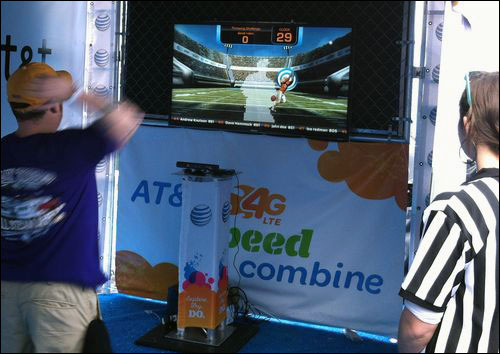Jan 18, 2012Spectators at this year's BCS National Championship, the final game in the Bowl Championship Series that begins with the Rose Bowl, were able to test their ability to throw, dodge and run like a professional football player, as well as share the results of their performances online via social networks, by employing RFID technology. The system was developed by marketing services firms Team Epic and Brightline Interactive, using RFID-enabled bracelets and readers provided by Fish Technologies. The companies have developed similar gesture-based applications for the U.S. Army, as well as for the Sports Illustrated (SI) Heisman Tour, a series of 10 college football games.
Team Epic has been working on digital interactive functionality that, according to Doug Lowry, the company's IT consultant, "gets the consumer involved at our onsite activations." The idea, he explains, is to transform ticket holders from mere spectators to event participants, allowing them to play games and then let friends and family members know what they are doing.
In 2010, Lowry says, Brightline Interactive developed a trivia game enabling sports fans to take on college football trivia, by using touch screens to select answers to game-related questions. Team Epic offered the solution at that year's Heisman Tour. "Along with the trivia games," he states, "we had touch screens installed onsite, where consumers can browse through archived SI imagery of their local college football team, enter into the SI Nissan sweepstakes, and browse Web sites that SI and Nissan wanted to promote."
For 2011, the company wanted to "step it up," and Brightline Interactive worked with Team Epic to develop custom Kinect video games (which feature a motion-sensing input device from Microsoft), in which participants would throw balls, run and dodge oncoming tackles digitally, and view their performance on screen. The technology utilized motion-sensing functionality, with Kinect hardware and software enabling players to use gestures to prompt actions on a digital screen. The participants could also play trivia games, either on the touch screen provided or on iPads, while each individual's results would be displayed on a large LED screen filling the adjacent wall.
This year, upon arriving at the Louisiana Superdome, in New Orleans—where the BCS National Championship was held on Jan. 9—each spectator first registered, providing his or name and Facebook or Twitter account name, as well as any personal details that individual wanted to share, such as the team he or she supported. That data was stored and linked to that person's unique ID number on a plastic wristband with a built-in NXP Semiconductors Mifare 1 kilobyte 13.56 MHz RFID chip, complying with the ISO 14443 standard, provided by the event staff at the ticket office. Participants wearing the wristbands could then go to one of six interactive games, known collectively as the AT&T Combine Challenge, and present the bracelet within a few inches of an HID Global Omnikey 5321 reader, provided by Fish Technology, to check in to their Facebook or Twitter account. The reader captured the wristband's ID number and forwarded that data to Brightline Interactive software, which linked that ID with the user's name and social-network details. The game screen would then greet each participant by name, indicating when it was that person's turn to play. As he or she played one of the games, the interactive game system tracked that individual's score and then displayed the result on screen, while also offering that player the choice of also posting the results on Facebook or Twitter. If the participant selected yes, the system would send the data via the Internet to the proper social-media site.
"Overall, we have been very pleased with both Brightline's development and creative teams, and we hope to continue bringing new and cutting-edge technology to our onsite activations," Lowry states.
"We are integrating RFID now into a lot of what we're doing," says Erik Muendel, Brightline Interactive's CEO and creative director. "We focus on the screen," he explains, which provides digital display and interactive gaming options to players. "But we find RFID is a gateway to get the message out to the public." Individuals could sign onto a Web-based system by providing their Facebook or other networking information when playing a game, which would not require RFID. However, he says, "That's a little clunky. RFID streamlines it."



